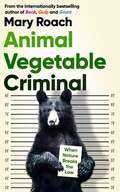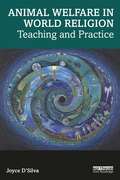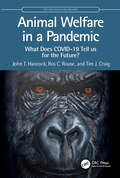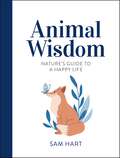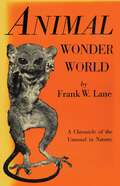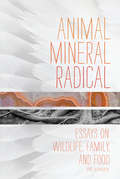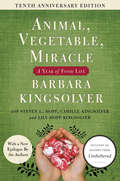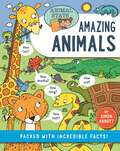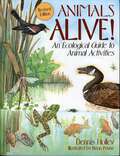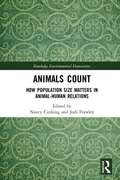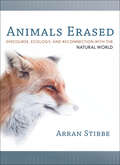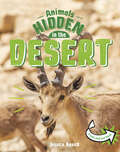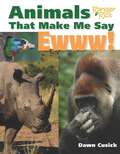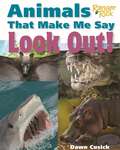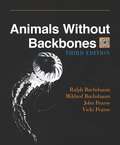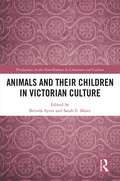- Table View
- List View
Animal Vegetable Criminal: When Nature Breaks the Law
by Mary RoachWhat&’s to be done about a jaywalking moose? A grizzly bear caught breaking and entering? A murderous tree? We&’ve never been good at sharing the planet… In the past, when wild animals &‘broke the law&’, they might be given lawyers and put on trial. But now, what&’s the solution when nature gets in our way? In this fresh, funny and thoroughly researched book, dive into the weird and wonderful moments when humanity and wildlife bump up against one another. Follow Mary Roach as she explores laser scarecrows, robo-hawks, human-elephant conflict specialists and monkey impersonators. Travel to the bear-busy back alleys of Aspen, the gull-vandalized floral displays at the Vatican and leopard-terrorized hamlets in the Himalayas, and discover hope for compassionate coexistence.
Animal Welfare
by Sir Colin SpeddingAwareness of the use of animals in human society in fields such as farming, biotechnology and sport is dogged by the lack of a clear and objective exposition of the issues involved and a sense of possible conflict between human and animal welfare. This text addresses these dilemmas - what is the actual scale of the animal welfare problem; where does responsibility begin; what positive steps are actually being taken to alleviate animal suffering; and can a rational and compelling argument be given for the importance of animal welfare. It therefore aims to offer a comprehensive guide to the uninformed as well as those who have knowledge of the issues but lack conviction.
Animal Welfare in World Religion: Teaching and Practice
by Joyce D'SilvaThis unique and readable book examines the relationship between religion and animal welfare, taking a detailed dive into the teachings and practices of the major world religions. While there are many books expounding the beliefs of the major religions and many about the rights and welfare of animals, there are few linking the two. With each chapter focusing on one of the five major religions – Judaism, Christianity, Islam, Hinduism and Buddhism – the book explores the beliefs and practices which drive our relationship with and treatment of animals. The book draws on the scriptures of the major faiths and includes the voices of leading historical religious figures and contemporary faith leaders. In doing so, it compares the teachings of old with contemporary practices and showcases the impact of the major religions on both the protection and exploitation of animals, from running animal sanctuaries, to participating in or condoning cruel sports and factory farming. Importantly, the book also includes a chapter looking beyond the major world religions, where it examines a wider range of beliefs and practices, including Indigenous peoples from the USA and Australia, Jainism, Sikhism and Rastafarianism, to provide fascinating insights into another range of beliefs and views on the human-animal relationship. Overall, this book challenges and encourages religious leaders and followers to re-examine their teachings and to prioritise the well-being of animals. This book is essential reading for those interested in the role of religion in animal welfare, human-animal studies, and animal welfare and ethics more broadly.
Animal Welfare in a Pandemic: What Does COVID-19 Tell us for the Future? (CRC One Health One Welfare)
by John T. Hancock Ros C. Rouse Tim J. CraigAnimal Welfare in a Pandemic explores the impact of COVID-19 on a wide array of animals, from those in the wild to companion and captive animals. During the height of the pandemic, a range of animals were infected, and many died, but this was hard to predict, even using up-to-date bioinformatics. Lockdowns around the world had, and continue to have, a major effect on animals’ welfare, influencing pet ownership and care, as well as impacting on the work of conservation institutes due to the lack of visitors and funding and lack of tourist presence in the wild which impacted on anti-poaching efforts. Some of the vast amount of personal protection equipment (PPE) that was distributed was discarded, creating both dangers and occasional opportunities for wild animals. With the rollout of human vaccines, some countries started developing animal vaccines, only some of which were deployed. In summary, the pandemic had a wide-ranging influence on animal welfare around the world. This is reviewed to highlight what can be learned to protect and enhance animal welfare in future epidemics/pandemics, and contribute to a genuinely One Health approach where the health and welfare of both humans and animals are considered holistically.This book is authored by members of the University of the West of England, Bristol, who span a range of expertise in Biological Sciences, Social Sciences, Animal Welfare, and Ethics.
Animal Wisdom: Nature's Guide to a Happy Life
by Sam HartSelf-care gone wild Slow down like a sloth, stretch like a cat, breathe deep like a whale and have the confidence of a lion. When life gets you down, lift your spirits with these tiny tips and helpful hints from our friends in the animal kingdom.
Animal Wonder World: A Chronicle of the Unusual in Nature
by Frank W. LaneThis is a charming series of essays on animal behavior, written in 1951 by the note British science writer Frank W. Lane, reveals obscure and fascinating oddities of animal behavior. The clear, logical explanation behind each bizarre happening grounds the observations in scientific research, and provides modern readers insight on mid-century scientific field methodology.Here are some of the cases featured in this fantastic compilation: Do bees tell time and tell each other of honey locations? Can game animals dodge bullets? Have fish an ear for music? Do birds hitch hike on each other&’s backs? These questions and thousands of others are answered with scientific proof.Natural history fans, history of science buffs, and explorers of nature will find hours of fascinating reading within. A true mine of conversational material and arbiter of game controversies!
Animal, Mineral, Radical: Essays on Wildlife, Family, and Food
by Bk Loren"Radical, before it meant a person who advocates strong political reform, meant getting to the root of things, the origin. It comes from the Latin radix, radicis,, meaning radish, a root vegetable."-BK LorenThese meditative essays range in subjects from a transcendental encounter with a pack of coyotes ironically juxtaposed with her neighbor's claim that nature "has gone out of vogue," to Loren's mother's slow yet all-encompassing deterioration from Parkinson's, and the unexpected way the Loma Prieta earthquake eroded her depression by offering the author a sense of her small place in a wild and worthwhile world.Loren has an empathetic and gentle approach to the world. In detailing the intricacies of human relationships and consciousness-fear of death and time, cooperation born of clashing viewpoints, tradition's beauty even when destructive, a love of language, a sense of loss amid the fast-paced materialistic world-she peels back the film of popular thinking in order to expose herself to the secrets so few of us ever see.
Animal, Vegetable, Miracle - 10th anniversary edition: A Year of Food Life
by Barbara Kingsolver Steven L. Hopp Camille Kingsolver Lily Hopp Kingsolver“A profound, graceful, and literary work of philosophy and economics, well tempered for our times, and yet timeless. . . . It will change the way you look at the food you put into your body. Which is to say, it can change who you are.” — Boston GlobeA 10th anniversary edition of Barbara Kingsolver's New York Times bestseller that describes her family's adventure as they move to a farm in southern Appalachia and realign their lives with the local food chainSince its publication in 2007, Animal, Vegetable, Miracle has captivated readers with its blend of memoir and journalistic investigation. Updated with original pieces from the entire Kingsolver clan, this commemorative edition explores how the family's original project has been carried forward through the years.When Barbara Kingsolver and her family moved from suburban Arizona to rural Appalachia, they took on a new challenge: to spend a year on a locally-produced diet, paying close attention to the provenance of all they consume. Concerned about the environmental, social, and physical costs of American food culture, they hoped to recover what Barbara considers our nation's lost appreciation for farms and the natural processes of food production. Since 2007, their scheme has evolved enormously. In this anniversary edition, featuring an afterword by the entire Kingsolver family, Barbara's husband, Steven, discusses how the project grew into a farm-to-table restaurant and community development project training young farmers in their area to move into sustainable food production. Camille writes about her decision to move back to a rural area after college, and how she and her husband incorporate their food values in their lives as they begin their new family. Lily, Barbara's youngest daughter, writes about how growing up on a farm, in touch with natural processes and food chains, has shaped her life as a future environmental scientist. And Barbara writes about their sheep, and how they grew into her second vocation as a fiber artist, and reports on the enormous response they've received from other home-growers and local-food devotees.With Americans' ever-growing concern over an agricultural establishment that negatively affects our health and environment, Animal, Vegetable, Miracle is a modern classic that will endure for years to come.
Animality and Children’s Literature and Film
by Amy RatelleExamining culturally significant works of children's culture through a posthumanist, or animality studies lens, Animality and Children's Literature and Film argues that Western philosophy's objective to establish a notion of an exclusively human subjectivity is continually countered in the very texts that ostensibly work to this end.
Animality in British Romanticism: The Aesthetics of Species (Routledge Studies in Romanticism)
by Peter HeymansThe scientific, political, and industrial revolutions of the Romantic period transformed the status of humans and redefined the concept of species. This book examines literary representations of human and non-human animality in British Romanticism. The book’s novel approach focuses on the role of aesthetic taste in the Romantic understanding of the animal. Concentrating on the discourses of the sublime, the beautiful, and the ugly, Heymans argues that the Romantics’ aesthetic views of animality influenced—and were influenced by—their moral, scientific, political, and theological judgment. The study reveals how feelings of environmental alienation and disgust played a positive moral role in animal rights poetry, why ugliness presented such a major problem for Romantic-period scientists and theologians, and how, in political writings, the violent yet awe-inspiring power of exotic species came to symbolize the beauty and terror of the French Revolution. Linking the works of Wordsworth, Blake, Coleridge, Byron, the Shelleys, Erasmus Darwin, and William Paley to the theories of Immanuel Kant and Edmund Burke, this book brings an original perspective to the fields of ecocriticism, animal studies, and literature and science studies.
Animals (Animal Stats)
by Simon AbbottDo you think you're an animal expert? Get the stats on the BIGGEST, the smallest, the fastest, the LOUDEST and much more!Packed with fascinating facts, stats and data, curious kids will be amazed to learn about the millions of animal species that share our planet, as well as habitats, animal adaptations and how to help our planet's biodiversity. Simon Abbott's fun characters draw in curious minds by answering the science and numeracy questions kids want to know, with the super-impressive answers found in nature!The Animal Stats series features accessible text paired with bright, colourful artwork, ideal for readers aged 6+, and includes a creature quiz at the back of the book to test their knowledge. Other titles in the series include Minibeasts, Sea Life and Dinosaurs.
Animals Alive!: An Ecologoical Guide to Animal Activities
by Walter Dennis HolleyA teacher's guide and resource book for designing and conducting live animal activities that are non-invasive and observation-oriented.
Animals Count: How Population Size Matters in Animal-Human Relations (Routledge Environmental Humanities)
by Nancy Cushing Jodi FrawleyWhether their populations are perceived as too large, just right, too small or non-existent, animal numbers matter to the humans with whom they share environments. Animals in the right numbers are accepted and even welcomed, but when they are seen to deviate from the human-declared set point, they become either enemies upon whom to declare war or victims to be protected. In this edited volume, leading and emerging scholars investigate for the first time the ways in which the size of an animal population impacts how they are viewed by humans and, conversely, how human perceptions of populations impact animals. This collection explores the fortunes of amphibians, mammals, insects and fish whose numbers have created concern in settler Australia and examines shifts in these populations between excess, abundance, equilibrium, scarcity and extinction. The book points to the importance of caution in future campaigns to manipulate animal populations, and demonstrates how approaches from the humanities can be deployed to bring fresh perspectives to understandings of how to live alongside other animals.
Animals Erased: Discourse, Ecology, and Reconnection with the Natural World
by Arran Stibbe“Amazingly clear and incisive readings of a wide range of discourses related to animals and ecology” from the author of Ecolinguistics (Karla Armbruster, coeditor of Beyond Nature Writing).Animals are disappearing, vanishing, and dying out—not just in the physical sense of becoming extinct, but in the sense of being erased from our consciousness. Increasingly, interactions with animals happen at a remove: mediated by nature programs, books, and cartoons; framed by the enclosures of zoos and aquariums; distanced by the museum cases that display lifeless bodies. In this thought-provoking book, Arran Stibbe takes us on a journey of discovery, revealing the many ways in which language affects our relationships with animals and the natural world. Animal-product industry manuals, school textbooks, ecological reports, media coverage of environmental issues, and animal-rights polemics all commonly portray animals as inanimate objects or passive victims. In his search for an alternative to these negative forms of discourse, Stibbe turns to the traditional culture of Japan. Within Zen philosophy, haiku poetry, and even contemporary children’s animated films, animals appear as active agents, leading their own lives for their own purposes, and of value in themselves.“Those of us of cultures of the land—both working with and, yes, consuming animals—will applaud Arran Stibbe’s analysis of the loss of soul when right relationship is discarded.” —Alastair McIntosh, author of Soil and Soul
Animals Hidden in the Desert (Animals Undercover)
by Jessica RusickSome desert creatures are masters of disguise! They use camouflage and cover to outsmart predators or sneak up on prey. Some desert animals blend in with rocks, sand, and more. Others burrow beneath the ground or hide in shrubs. Can you spot the creatures hidden in the desert?
Animals Hidden in the Forest (Animals Undercover)
by Jessica RusickSome forest creatures are masters of disguise! They use camouflage and cover to outsmart predators or sneak up on prey. Some forest animals blend in with leaves, moss, and more. Others hide beneath rocks or in logs. Can you spot the creatures hidden in the forest?
Animals Hidden in the Ocean (Animals Undercover)
by Jessica RusickSome ocean creatures are masters of disguise! They use camouflage and cover to outsmart predators or sneak up on prey. Some ocean animals blend in with sand, pebbles, and more. Others hide in coral reefs or beneath the ocean floor. Can you spot the creatures hidden in the ocean?
Animals Hidden in the Snow (Animals Undercover)
by Jessica RusickSome creatures are masters of disguise! They use camouflage and cover to outsmart predators or sneak up on prey. In cold habitats, animals blend in with the snowy surroundings. They also hide beneath the snow in dens. Can you spot the creatures hidden in the snow?
Animals That Make Me Say Ewww! (Animals That Make Me Say...)
by Dawn CusickThat&’s so gross! Prepare to be grossed out by an engaging and unique look at some of the more disgusting survival techniques from the animal kingdom. From blood-squirting reptiles to blood-sweating mammals to nose-picking primates, learn about some of the most disgusting creatures in the animal kingdom. Author Dawn Cusick and the National Wildlife Federation compile a volume as attractive as its subject is disgusting.
Animals That Make Me Say Look Out! (Animals That Make Me Say...)
by Dawn CusickHey! Look out! Sharp-eyed readers will need to keep their eyes peeled in this engaging look at how animals of all shapes and sizes blend in and survive in their native ecosystems. How do animals deal with danger? From crocodiles standing on their tails to great white sharks with their jaws wide open to well-camouflaged venomous snakes, prospective naturalists and conservationists will have a lot to look out for in this exploration of dynamic ecosystems and the animals that hide and hunt in them. Back matter includes glossary, curated reading list and a scavenger hunt.
Animals Without Backbones: An Introduction to the Invertebrates (New Plan Texts at the University of Chicago)
by John Pearse Ralph Buchsbaum Mildred Buchsbaum Mildredd BuchsbaumAnimals Without Backbones has been considered a classic among biology textbooks since it was first published to great acclaim in 1938. It was the first biology textbook ever reviewed by Time and was also featured with illustrations in Life. Harvard, Stanford, the University of Chicago, and more than eighty other colleges and universities adopted it for use in courses. Since then, its clear explanations and ample illustrations have continued to introduce hundreds of thousands of students and general readers around the world to jellyfishes, corals, flatworms, squids, starfishes, spiders, grasshoppers, and the other invertebrates that make up ninety-seven percent of the animal kingdom. This new edition has been completely rewritten and redesigned, but it retains the same clarity and careful scholarship that have earned this book its continuing readership for half a century. It is even more lavishly illustrated than earlier editions, incorporating many new drawings and photographs. Informative, concise legends that form an integral part of the text accompany the illustrations. The text has been updated to include findings from recent research. Eschewing pure morphology, the authors use each group of animals to introduce one or more biological principles. In recent decades, courses and texts on invertebrate zoology at many universities have been available only for advanced biology majors specializing in this area. The Third Edition of Animals Without Backbones remains an ideal introduction to invertebrates for lower-level biology majors, nonmajors, students in paleontology and other related fields, junior college and advanced high school students, and the general reader who pursues the rewarding study of the natural world.
Animals and Society: An Introduction to Human-Animal Studies
by Margo DeMelloConsidering that much of human society is structured through its interaction with non-human animals, and since human society relies heavily on the exploitation of animals to serve human needs, human–animal studies has become a rapidly expanding field of research, featuring a number of distinct positions, perspectives, and theories that require nuanced explanation and contextualization. <P><P>The first book to provide a full overview of human–animal studies, this volume focuses on the conceptual construction of animals in American culture and the way in which it reinforces and perpetuates hierarchical human relationships rooted in racism, sexism, and class privilege. Margo DeMello considers interactions between humans and animals within the family, the law, the religious and political system, and other major social institutions, and she unpacks the different identities humans fashion for themselves and for others through animals. Essays also cover speciesism and evolutionary continuities; the role and preservation of animals in the wild; the debate over zoos and the use of animals in sports; domestication; agricultural practices such as factory farming; vivisection; animal cruelty; animal activism; the representation of animals in literature and film; and animal ethics. Sidebars highlight contemporary controversies and issues, with recommendations for additional reading, educational films, and related websites. DeMello concludes with an analysis of major philosophical positions on human social policy and the future of human–animal relations.
Animals and Their Children in Victorian Culture (Perspectives on the Non-Human in Literature and Culture)
by Brenda Ayres Sarah Elizabeth MaierWhether a secularized morality, biblical worldview, or unstated set of mores, the Victorian period can and always will be distinguished from those before and after for its pervasive sense of the "proper way" of thinking, speaking, doing, and acting. Animals in literature taught Victorian children how to be behave. If you are a postmodern posthumanist, you might argue, "But the animals in literature did not write their own accounts." Animal characters may be the creations of writers’ imagination, but animals did and do exist in their own right, as did and do humans. The original essays in Animals and Their Children in Victorian explore the representation of animals in children’s literature by resisting an anthropomorphized perception of them. Instead of focusing on the domestication of animals, this book analyzes how animals in literature "civilize" children, teaching them how to get along with fellow creatures—both human and nonhuman.
Animals as Experiencing Entities: Theories and Historical Narratives (The Palgrave Macmillan Animal Ethics Series)
by Les Mitchell Michael J. GloverThis volume explores the experiences of those with little or no power—usually, although not exclusively, animals. The theme of animals as experiencing entities is what links the chapters and characterises the volume. Broadly each author in this volume contributes in one of two ways. The first group, in Section 1, theoretically engages animal subjectivity, animal experiences, and ways in which these are to some extent accessible and knowable to humans. The second group of authors, in Section 2, offer narrative accounts about specific animals or groups of animals and explore to some extent their subjective historical experiences. In summary, the first section diversely theorises about animal experiences, while the second section’s authors assume animals’ subjective experiences and construct narratives that take into account how animals might have subjectively experienced historical phenomena.
Animals as Neighbors: The Past and Present of Commensal Animals (The Animal Turn)
by Terry O'ConnorIn this fascinating book, Terry O’Connor explores a distinction that is deeply ingrained in much of the language that we use in zoology, human-animal studies, and archaeology—the difference between wild and domestic. For thousands of years, humans have categorized animals in simple terms, often according to the degree of control that we have over them, and have tended to see the long story of human-animal relations as one of increasing control and management for human benefit. And yet, around the world, species have adapted to our homes, our towns, and our artificial landscapes, finding ways to gain benefit from our activities and so becoming an important part of our everyday lives. These commensal animals remind us that other species are not passive elements in the world around us but intelligent and adaptable creatures. Animals as Neighbors shows how a blend of adaptation and opportunism has enabled many species to benefit from our often destructive footprint on the world. O’Connor investigates the history of this relationship, working back through archaeological records. By requiring us to take a multifaceted view of human-animal relations, commensal animals encourage a more nuanced understanding of those relations, both today and throughout the prehistory of our species.
